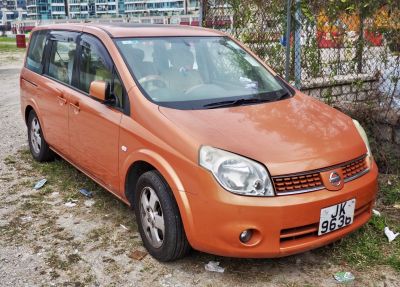 1991 Mitsubishi Chariot (E-N33W) Dimensions, Size & Specs
1991 Mitsubishi Chariot (E-N33W) Dimensions, Size & SpecsMeasurements of the 1991 Mitsubishi Chariot, engineered for optimal performance and comfort
| Dimensions | |
|---|---|
| Length: | 4515 mm177.8 in14.8 ft |
| Width: | 1695 mm66.7 in5.6 ft |
| Height: | 1580-1595 mm62.2-62.8 in5.2-5.2 ft |
| Trunk Capacity: | 128 liter4.5 cu ft |
| Trunk Capacity (Max): | 1385 liter48.9 cu ft |
| Weight Specifications | |
| Curb Weight: | 1370-1400 kg3020-3086 lbs |
| Tire Specifications | |
| Rims Size: |
|
| Tire Sizes: |
|
The Mitsubishi Chariot (E-N33W), produced between 1991 and 1997, is a versatile minivan that stands out in the early 1990s vehicle segment for its practical size and spacious interior. With an overall length of 4515 mm (177.6 inches) and a width of 1695 mm (66.7 inches), this minivan offers a balanced footprint ideal for urban maneuverability and family use. The height ranges from 1580 mm to 1595 mm (62.2 to 62.8 inches), providing sufficient headroom for passengers while maintaining a low center of gravity for stable handling. Weighing between 1370 kg and 1400 kg (about 3020 to 3086 lbs), the Chariot delivers a solid build without being overly hefty, contributing to efficient fuel economy for its class.
One of the vehicle’s standout features is its flexible luggage capacity: 128 liters (4.5 cubic feet) with all seats in place and expanding to an impressive 1385 liters (48.9 cubic feet) once the rear seats are folded down. This adaptability makes the E-N33W model suited for families and users needing to transport larger cargo without sacrificing passenger comfort. The Chariot rides on 14-inch rims fitted with either 185/70 R14 H or 205/65 R14 H tires, providing a balance of ride comfort and road grip suitable for diverse driving conditions.
Overall, the Mitsubishi Chariot (E-N33W) minivan from 1991-1997 combines practical dimensions, adaptable interior space, and reliable engineering, appealing to those seeking a family-friendly vehicle from the early 90s era. Its size and weight place it comfortably among mid-sized minivans, making it a noteworthy option for collectors and enthusiasts interested in classic Japanese multi-purpose vehicles.
Discover the standout features that make the 1991 Mitsubishi Chariot a leader in its class
Have a question? Please check our knowledgebase first.
The Mitsubishi Chariot (E-N33W), produced between 1991 and 1997, is a minivan designed with a practical size. It measures 4515 mm (177.6 inches) in length, 1695 mm (66.7 inches) in width, and its height varies slightly between 1580 mm (62.2 inches) and 1595 mm (62.8 inches) depending on the specific model and configuration. These dimensions place the Chariot comfortably within the compact minivan category of its era, offering enough room for passengers and cargo without being overly large or cumbersome for urban use.
The Mitsubishi Chariot (E-N33W) has a curb weight ranging between 1370 kg (around 3020 lbs) and 1400 kg (approximately 3086 lbs). This weight is fairly typical for a compact minivan of the early 1990s, balancing enough mass for stable on-road driving with manageable fuel consumption. The weight influences ride comfort and handling; the Chariot’s moderate weight helps provide a stable and comfortable ride, while keeping agility reasonable for city driving and longer journeys. It also impacts acceleration and braking—drivers can expect a smooth experience given its size and purpose.
The Mitsubishi Chariot (E-N33W) offers versatile luggage capacity tailored to passenger and cargo needs. With all seats in place, the vehicle provides a modest 128 liters (approximately 4.5 cubic feet) of luggage space, suitable for small bags or groceries. When the rear seats are folded down, this capacity expands dramatically to 1385 liters (about 48.9 cubic feet), allowing for much larger cargo loads like bulky items or several suitcases. This adaptability is a key feature for a minivan designed for families or those who frequently switch between passenger and cargo transport.
A standard residential garage typically measures around 2400 mm (8 feet) in width and 4800 mm (16 feet) in length. The Mitsubishi Chariot’s length of 4515 mm (177.6 inches) and width of 1695 mm (66.7 inches) fit comfortably within these dimensions, leaving enough clearance for easy parking and maneuvering. Its height of up to 1595 mm (62.8 inches) is generally not an issue unless the garage ceiling is unusually low, which is rare. Therefore, the Chariot should comfortably fit into most single-car garages, making it convenient for homeowners.
In the early 1990s, minivans typically ranged in width from about 1700 mm to 1850 mm (67 to 73 inches) and in height from roughly 1600 mm to 1800 mm (63 to 71 inches). The Mitsubishi Chariot sits on the narrower and slightly lower end of this spectrum with a width of 1695 mm (66.7 inches) and height between 1580 mm and 1595 mm (62.2 to 62.8 inches). This makes the Chariot more compact than many contemporaries, which may provide better maneuverability and easier parking, especially in tighter urban environments, though it could offer slightly less interior volume compared to wider, taller minivans.
The Mitsubishi Chariot (E-N33W) came with 14-inch rims as standard. Tire sizes offered included 185/70 R14 H and 205/65 R14 H. These tire sizes were typical for vehicles in its class at the time, providing a good balance between comfort and handling. The 185/70 R14 tires focused more on ride comfort and fuel efficiency, while the slightly wider 205/65 R14 tires offered better grip and stability, especially important for passenger safety and handling performance.
Compared to its predecessor, the Mitsubishi Chariot (E-N33W) introduced in 1991 featured refined exterior dimensions and improved interior space utilization. The length of 4515 mm (177.6 inches) offered a marginal increase over previous models, enhancing cabin and cargo room. The width at 1695 mm (66.7 inches) remained relatively consistent, maintaining maneuverability. The luggage capacity with rear seats folded (1385 liters or 48.9 cubic feet) saw improvements due to better seat folding mechanisms and interior layout. Overall, the E-N33W generation balanced size increases to boost comfort without sacrificing drivability in urban environments.
During the early to mid-1990s, many minivans such as the Toyota Previa, Honda Odyssey, and Nissan Prairie were competing in the compact to mid-size range. The Mitsubishi Chariot (E-N33W) is somewhat more compact and narrower than many of its peers, with a length of 4515 mm (177.6 inches) and width of 1695 mm (66.7 inches). While this rendered it slightly smaller in overall footprint, its flexible seating arrangement and impressive expanded luggage capacity of 1385 liters (48.9 cubic feet) with seats folded made it a practical choice. The Chariot was especially suited for drivers seeking easier maneuverability without sacrificing interior versatility.
The Mitsubishi Chariot’s exterior width of 1695 mm (66.7 inches) provides a cabin that comfortably seats passengers without excess bulk. While narrower than some competitors, the minivan still offers adequate shoulder room inside for up to seven passengers in various layouts. The height, ranging from 1580 mm to 1595 mm (62.2 to 62.8 inches), enables sufficient headroom and a higher seating position, which enhances visibility for the driver and passengers. This compact yet roomy design ensures that occupants experience comfort on longer trips while the vehicle maintains a manageable size on the road, improving agility and parking ease.
Weighing between 1370 kg (3020 lbs) and 1400 kg (3086 lbs), the Mitsubishi Chariot (E-N33W) maintains a curb weight that supports reasonable fuel efficiency for a minivan of its time. The relatively moderate weight means the engine doesn’t have to work excessively hard, positively influencing fuel consumption and acceleration. Combined with its compact exterior dimensions (4515 mm long and 1695 mm wide), the vehicle balances carrying capacity with efficiency. Drivers could expect practical performance for daily urban driving and family transport with less impact on fuel economy than larger, heavier minivans.
Discover similar sized cars.

| Production: | 2004-2007 |
|---|---|
| Model Year: | 2005 |
| Length: | 4495 mm177.0 in |
| Width: | 1695 mm66.7 in |
| Height: | 1615 mm63.6 in |

| Production: | 1998-2003 |
|---|---|
| Model Year: | 1998 |
| Length: | 4515 mm177.8 in |
| Width: | 1695 mm66.7 in |
| Height: | 1580 mm62.2 in |

| Production: | 1991-1998 |
|---|---|
| Model Year: | 1991 |
| Length: | 4515 mm177.8 in |
| Width: | 1695 mm66.7 in |
| Height: | 1615-1630 mm63.6-64.2 in |

| Production: | 1999-2004 |
|---|---|
| Model Year: | 1999 |
| Length: | 4515 mm177.8 in |
| Width: | 1695 mm66.7 in |
| Height: | 1620 mm63.8 in |
